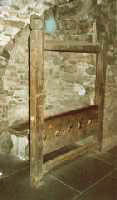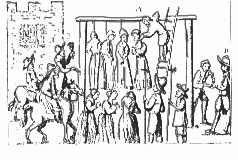Women and plantation
Men formed the majority of the New English, whether as administrators, soldiers or settlers and the English authorities were concerned at the extent of their relations with Irish women.
The women, as one commentator put it, 'lye in the bosomes of ore greate men, to maintaine the cutting of ore throats; to prevent the devises of ore governors; to hinder the cuttinge of ore enemies'.
There was also concern that the children of such relationships would be brought up in the unsavoury habits and customs of their mothers. As Spenser noted: 'How can such matching but bring forth an evil race, seeing that commonly the child taketh most of his nature of the mother?'
Mary O'Dowd, 'Women and the law in early modern Ireland' in Christine Meek (ed.), Women in Renaissance and early modern Europe, Dublin, 2000, p.101. |
Men who married Gaelic women would be excluded from the colonial élite, so most of them married English women, chose partners from the small pool of English families already living in Ireland or brought wives and families over from England.
Women often had to arrange the disposal of property in England and make travel arrangements for themselves, their children and members of the extended family who were to accompany them to Ireland. Travel was on horseback, on carts or coaches and long days could be spent in ports waiting for favourable winds for sailing vessels. Robbery and even piracy were among the hazards, together with contagious and often fatal diseases in the cramped conditions of the ports.
On arrival, they might live in primitive accommodation while their new homes, whether plantation castles or houses were being built. They might have brought household utensils, vessels, linen and feather beds as well as items of prestige for decoration and stock and seeds for their yards and gardens. They encountered hostility from the native Irish and there were several military campaigns during the seventeenth century which brought hardship and tragedy both to the planters and those they supplanted. Some were disillusioned with life in Ireland and returned to England.
|
Gender tension was rife in the England and Scotland they had left behind where the law was frequently used to keep women under control. Women there could be prosecuted by local courts for the offences of gossip and scolding and they were punished by humiliation: they were placed in stocks in the market place or fastened in ducking stools to dip them in the water.
On arrival in Ireland some of the new settlers introduced ducking stools and stocks but the practice does not seem to have been widespread.
|

Stocks
Used in Dublin.
Preserved in the crypt of Christchurch Cathedral. |
Therefore I do ordain that henceforwards no single woman other than hired servants for meat, drink and wages or clothes shall draw any ale or beer or keep victualling in this town, upon pain to be set in the stocks by the constable for 3 whole market days one after another ... and [the constable] to banish any single woman out of this town that now or hereafter shall be found with child, first setting such in stocks for 12 hours for the terror and example of others.
Laurence Parsons, Ordinance for the regulation of drinking houses, etc. in Birr in the year 1626, Rosse Mss., Birr Castle. |
|
There is no evidence for the existence in Ireland of the witch hunts that characterised much of early modern Europe where over a hundred thousand witches were condemned in the sixteenth and seventeenth centuries. Thousands, mostly poor old women, were prosecuted for witchcraft in England and Scotland. Many were tortured for information and those convicted burned at the stake or hanged.
|

Witches hanged in England in the 17th century
|
|
Only one full scale trial, that of Florence Newtown at Youghal in 1661, is known of. This case has many of the features typical of English trials of the period. Florence appears to have been a poor woman who asked Mary Londgon, a servant of John Pyne, for a piece of beef. Mary refused and within a fortnight fell ill, blaming Florence for bewitching her. The outcome of the trial is not known ... Occasionally there are incidental references to other Irish witchcraft trials. In 1678, for instance, a woman called Bessie Weir was burnt at Paisley in Scotland as a witch. She had been tried and convicted in Ireland before but had reputedly been freed by the devil before she could be executed.
Raymond Gillespie, 'Women and crime in seventeenth century Ireland' in Margaret MacCurtain & Mary O'Dowd (eds.), Women in early modern Ireland, Dublin, 1991, p. 45.
|
Questions
- Women members of families moving to plantations in Ireland often had to arrange the ___ of ___ in England.
- Suggest three serious problems such women faced in travelling to Ireland.
- Gender ___ was rife in ____ and ____ and the law was frequently used to keep ____ under ____.
- Suggest reasons why gossip and scolding were offences for women in England but not for men.
- Suggest the major differences for women between life in England and life in Ireland.
- Only one full witch ___, that of Florence ____ at Youghal in ____, is known of. She asked Mary ____ for a piece of ___. Mary refused and within a ____, fell ill, blaming Florence for ____ her.
Activities
- Research the experience of women in a plantation of your choice.
- Research witch hunts in England, Scotland or Europe during the early modern period.
- Write a letter from a woman in England to her husband dealing with business in connection with plantation in Ireland. She tells him what arrangements she is making and asks him for information about Ireland.
- Write a letter from a husband in Ireland to his wife in England dealing with business in connection with plantation. Tell her about life in Ireland and ask for information about home in England.
- Organise a mock trial of Florence Newtown at Youghal in 1661 on the charge of witchcraft.
- Organise a mock trial of a single woman accused of drawing ale, beer and victualling in Birr in 1626.
- Make a scale model of a set of stocks and/or a ducking stool. Perhaps make them to the scale of a doll and demonstrate their use.

